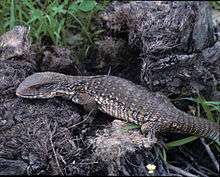Savannah monitor
| Savannah monitor | |
|---|---|
 | |
| Scientific classification | |
| Kingdom: | Animalia |
| Phylum: | Chordata |
| Subphylum: | Vertebrata |
| Class: | Reptilia |
| Order: | Squamata |
| Suborder: | Lacertilia |
| Family: | Varanidae |
| Genus: | Varanus |
| Subgenus: | V. (Polydaedalus) |
| Species: | V. exanthematicus |
| Binomial name | |
| Varanus exanthematicus (Bosc, 1792) | |
The savannah monitor (Varanus exanthematicus) is a medium-sized species of monitor lizard native to Africa. The species is known as Bosc's monitor in Europe, since French scientist Louis Bosc first described the species.[1] It belongs to the subgenus Polydaedalus, along with the Nile, the ornate and other monitors.
Etymology
The specific name exanthematicus is derived from the Greek word exanthem /ɛkˈsænθɪm/ meaning an eruption or blister of the skin.[2] French botanist and zoologist Louis Augustin Guillaume Bosc originally described this lizard as Lacerta exanthematica in reference to the large oval scales on the back of its neck.[1]
Description
Bosc's or savannah monitors are stoutly built, with relatively short limbs and toes, and skulls and dentition adapted to feed on hard-shelled prey. Maximum size is usually between 105 and 155 cm (3.5 to 5.0 ft) in length, although most specimens collected in the wild ranged from 60 to 76 cm (2 to 2.5 ft) with females being considerably smaller. The pattern of coloration of the skin varies according to the local habitat substrate. The body scales are large, usually less than 100 scales around midbody, a partly laterally compressed tail with a double dorsal ridge and nostrils equidistant from the eyes and the tip of the snout.[3]
Diet
Information about the diet of savannah monitors in the wild has been recorded in Senegal[4] and Ghana.[5][6] It feeds almost exclusively on arthropods and molluscs. In Senegal, Iulus millipedes were the most common prey of adults; in Ghana, small crickets formed the bulk of the diet of animals less than two months old; orthopterans (especially Brachytrupes), scorpions and amphibians were the most common prey of animals six to seven months old .
Temperament in captivity
The Savannah monitor is a rather popular lizard pet in the trade. This is due to their docile disposition and they are one of the least-likely-to-bite monitors with proper handling. Household pets such as cats and dogs will likely not be seen as a threat if the monitor is raised alongside them.
Range
Its range extends throughout sub-Saharan Africa from Senegal east to Sudan and south almost to the Congo River and Rift Valley, where they are replaced by V. albigularis.[5] V. exanthematicus is primarily a ground-dwelling species that shelters in burrows, although it is sometimes found in bushes or low trees.[3] In the coastal plain of Ghana, V. exanthematicus juveniles are often associated with the burrows of the giant cricket Brachytrupes.[7]
Threats
Varanus exanthematicus is listed as Least Concern by IUCN.[8] The species is hunted for its leather and meat and for the international pet trade. An average of 30,574 live specimens were imported into the US each year between 2000 and 2009; total imports of live specimens into the US between 2000 and 2010 was 325,480 animals. During the same period, 1,037 skins, shoes, and products of the species were imported into the US. Trade in live animals comes mainly from Ghana (235,903 animals exported between 2000 and 2010), Togo (188,110 animals exported between 2000 and 2010), and Benin (72,964 animals exported between 2000 and 2010). During the same period, total worldwide declared exports of skins and products of the species totalled 37,506.[9] However, there is substantial undeclared trade in the species from Sudan, Nigeria and elsewhere[8]
Further reading
- Bennett, D. 2000. The density and abundance of juvenile Varanus exanthematicus (Sauria: Varanidae) in the coastal plain of Ghana. Amphibia-Reptilia 21(3): 301–306.
- Bennett, D, and R. Thakoordyal. 2003. The savannah monitor lizard: the truth about Varanus exanthematicus. Viper Press, Glossop. 2003: 1–83.
- 1993. The Savanna Monitor (Varanus exanthematicus) in Africa and in your home. The Iowa Herpetological Society June: 2-4 (Reprinted in International Reptile Breeders Association (IRBA), Monitor 1(2):1 0-12, 1994).
- Bennett, D. & Sweet, S.S. 2010. Varanus exanthematicus. In: IUCN 2011. IUCN Red List of Threatened Species. Version 2011.2. <www.iucnredlist.org>.
References
- 1 2 Bosc, Louis. Lacerta exanthematica. Act. Soc. Hist. Nat. Paris 1. p. 25.
- ↑ Oxford English Dictionary (1989). Oxford English Dictionary. Oxford: Clarendon Press.
- 1 2 Bennett, Daniel; Ravi Thakoordyal (2003). The Savannah Monitor, the Truth about Varanus exanthematicus. UK: Viper Press. p. 84. ISBN 0-9526632-9-5.
- ↑ Cisse, M (1972). "L'alimentaire des Varanides au Senegal". Bulletin L'Institute Fond. Afr. Noire. 34: 503–515.
- 1 2 Bennett, Daniel (2004). "Chapter 5.2: Varanus exanthematicus". In Pianka, Eric R. Varanoid Lizards of the World. Indiana University Press. pp. 95–103. ISBN 0-253-34366-6.
- ↑ Bennett, Daniel (2000). "Preliminary data on the diet of juvenile Varanus exanthematicus in the coastal plain of Ghana". Herpetological Journal. 10: 75–76.
- ↑ Bennett, Daniel (2000). "Observations of Bosc's monitor lizard (Varanus exanthematicus) in the wild". Bulletin of Chicago Herpetological Society. 35: 177–180.
- 1 2 Bennett, D.; Sweet, S. (2010). "Varanus exanthematicus.". In: IUCN 2011. IUCN Red List of Threatened Species. Version 2011.2. IUCN. Retrieved 5 April 2012.
- ↑ "CITES Trade Database". CITES. Retrieved 5 April 2012.
External links
| Wikispecies has information related to: Varanus exanthematicus |
| Wikimedia Commons has media related to Varanus exanthematicus. |
- Photo of Savanna monitor
- http://www.savannahmonitor.co/ Care and info
